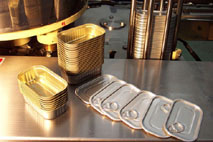JK SOMME has been continuously manufacturing can seamers since 1905.
The Spain based company is currently managed by the 3rd & 4th generation of the Somme family (Oscar K. Somme and his son Axel). The family hailed originally from Norway, and company founder Johanes Somme (first Norwegian Consul in Bilbao) was born there in the city of Stavanger.
JK SOMME is a world leader in the manufacturing of can seamers for non round cans. Our customers are mostly fish canneries, as this is the business where such cans are most widely used (1/4 club, dingley, oval, hansa, etc.). However we also make round can and mechanical vacuum seamers.
Yearly production is about 40-50 machines, 90% of which are exported. Our MASTER and VIKING can be found working from Peru to Denmark to Indonesia. We can provide references from practically every country in the world, as we have supplied over 6000 can seamers in our long history.
Over this time we have consolidated a fast, efficient after-sales service. Now we have official service centers in Galicia, France, Northern Europe, North Africa, Thailand and South America (JK SOMME de las Américas). When you purchase a JK SOMME can seamer you can rest assured that you have the backing of a top-level spare-parts and technical assistance service, wherever you may be.
In mid 2008 we moved to a new, modern plant in the town of Villasana de Mena (Burgos), in an incomparable setting still just 30 km from the centre of Bilbao. The plant comprises a 1200 m2 rectangular building divided up into offices, manufacturing shop, adjustment shop, warehouse and assembly shop.

FUTURE DEVELOPMENTS
THE "IN BLUE" CONCEPT - THE "EXCLUSIVITY" CONCEPT
We have recently implemented a new design philosophy under the name "IN BLUE". This involves not just aesthetic changes but also seeks to distinguish our products and bring originality back into the design of can seamers.
Our machines are not just the most reliable but now they are the most exclusive.
Our intention is to change the way in which our customers think of can seamers.
For many years the biggest "bottle neck" in the production of canned sardines was the putting on of the lids. They had to be soldered and place one by one by a huge gang of solderers/tin metal workers. In the course of a ten hour working day these "knights of the soldering iron" could put the lids onto about 600 tins, or on average one can per minute. If we compare this to the speed of the layers, the dimensions of this "bottle neck" become apparent. It was therefore necessary for the solderers to do a considerable amount of overtime.
Many people in the canning milieu in Stavanger (Norway) endeavoured to make this part of the working operation more efficient, either by improving the soldering technique, or by creating a machine that could do the job. The breakthrough came just after the turn of the century when two different folding and sealing machines were patented. One of these was developed by Soren Opsal, the other by Henrik J. Reinart. These machines made possible the mass production of canned sardines. The normal capacity of one of these machines was 7.000 cans per day (15 cans/minute).
Since theses early days the can sealing-seaming machines have been steadily improved up to a seaming capacity of 15.000 rectangular cans per hour - 250 cans/minute and up to 120.000 round cans per hour - 2000 cans/minute (beverage).